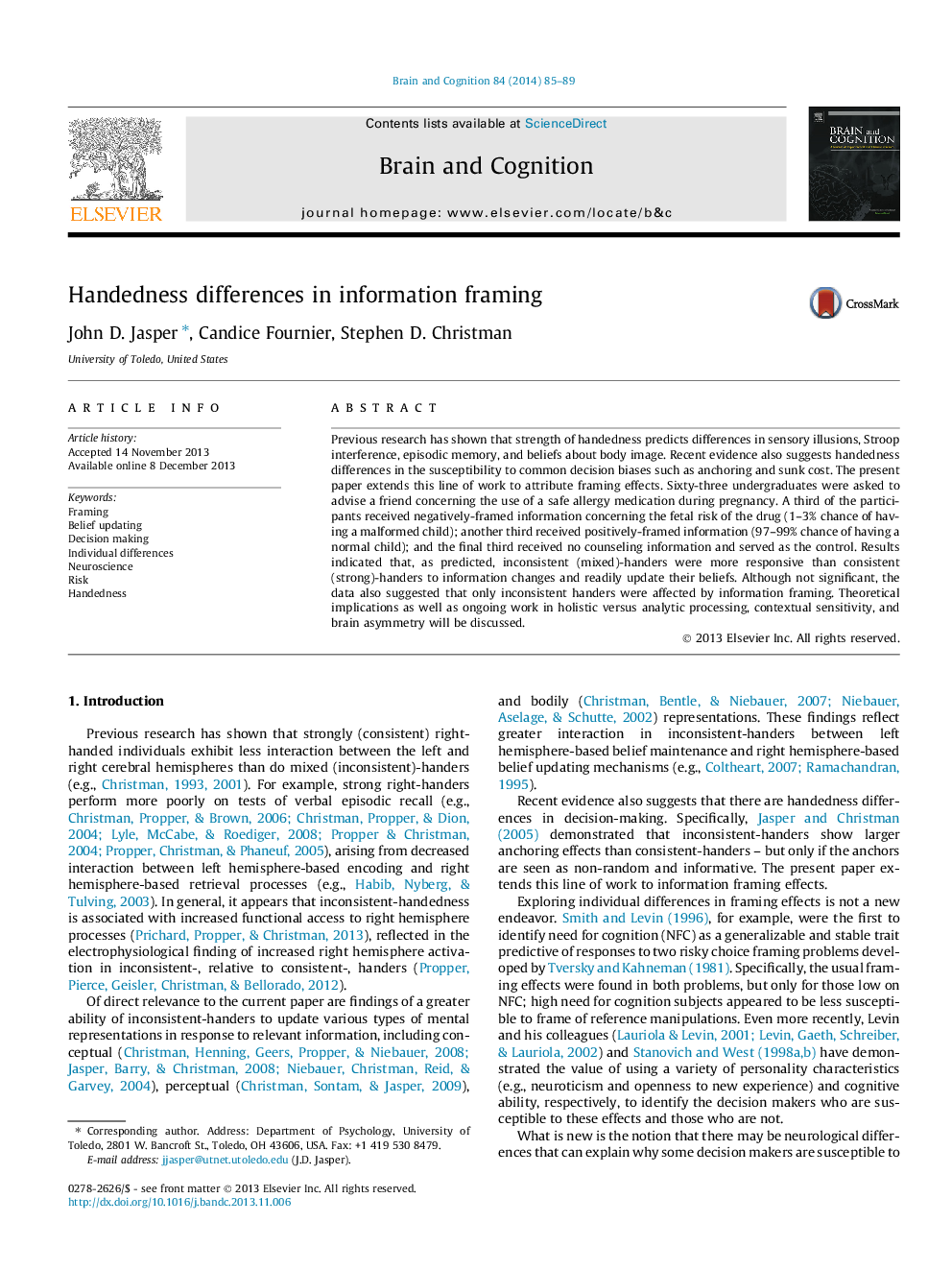| کد مقاله | کد نشریه | سال انتشار | مقاله انگلیسی | نسخه تمام متن |
|---|---|---|---|---|
| 10455566 | 921187 | 2014 | 5 صفحه PDF | دانلود رایگان |
عنوان انگلیسی مقاله ISI
Handedness differences in information framing
ترجمه فارسی عنوان
اختلاف دستی در فریم اطلاعات
دانلود مقاله + سفارش ترجمه
دانلود مقاله ISI انگلیسی
رایگان برای ایرانیان
کلمات کلیدی
کادر بندی، به روز رسانی اعتقاد، تصمیم سازی، تفاوتهای فردی، علوم اعصاب، خطر، دستیابی،
ترجمه چکیده
تحقیقات قبلی نشان داده است که استحکام دست، اختلاف در توهمات حسی، تداخل استروپ، حافظه اپیزودیک و باورهای مربوط به تصویر بدن را پیش بینی می کند. شواهد اخیر نشان می دهد که اختلاف دستوری در حساسیت به سوگیری های تصمیم گیری مشترک مانند لنگرگاه و هزینه های غرق شده است. مقاله حاضر این خط از کار را به اثبات اثرات قاب سازی گسترش می دهد. شصت و سه دانشجوی کارشناسی خواسته شد که یک دوست در مورد استفاده از داروهای آلرژی ایمن در دوران بارداری توصیه کند. یک سوم از شرکت کنندگان در مورد خطر ابتلا به مواد مخدر (احتمال 1-3٪ داشتن یک کودک ناقص) اطلاعاتی منفی محسوب می شود. یک سوم اطلاعاتی مثبت دریافت شده (99-99٪ احتمال داشتن یک کودک معمولی)؛ و سومین نهایی هیچ اطلاعات مشاوره ای دریافت نکرده و به عنوان کنترل به کار گرفته شد. نتایج نشان داد که به عنوان پیش بینی، ناسازگاری (مخلوط)، بیشتر پاسخگو بود از سازگار (قوی) به تغییرات اطلاعات و به راحتی باور های خود را به روز رسانی. گرچه مهم نیست، داده ها همچنین نشان می دهند که تنها ناقلین داده های ناسازگار توسط فریم بندی اطلاعات تحت تاثیر قرار می گیرند. مفاهیم نظری و همچنین کارهای در حال انجام در پردازش جامع در مقابل تحلیلی، حساسیت متنی و عدم تقارن مغزی مورد بحث قرار خواهد گرفت.
موضوعات مرتبط
علوم زیستی و بیوفناوری
علم عصب شناسی
علوم اعصاب شناختی
چکیده انگلیسی
Previous research has shown that strength of handedness predicts differences in sensory illusions, Stroop interference, episodic memory, and beliefs about body image. Recent evidence also suggests handedness differences in the susceptibility to common decision biases such as anchoring and sunk cost. The present paper extends this line of work to attribute framing effects. Sixty-three undergraduates were asked to advise a friend concerning the use of a safe allergy medication during pregnancy. A third of the participants received negatively-framed information concerning the fetal risk of the drug (1-3% chance of having a malformed child); another third received positively-framed information (97-99% chance of having a normal child); and the final third received no counseling information and served as the control. Results indicated that, as predicted, inconsistent (mixed)-handers were more responsive than consistent (strong)-handers to information changes and readily update their beliefs. Although not significant, the data also suggested that only inconsistent handers were affected by information framing. Theoretical implications as well as ongoing work in holistic versus analytic processing, contextual sensitivity, and brain asymmetry will be discussed.
ناشر
Database: Elsevier - ScienceDirect (ساینس دایرکت)
Journal: Brain and Cognition - Volume 84, Issue 1, February 2014, Pages 85-89
Journal: Brain and Cognition - Volume 84, Issue 1, February 2014, Pages 85-89
نویسندگان
John D. Jasper, Candice Fournier, Stephen D. Christman,
